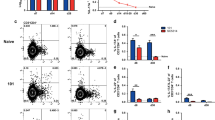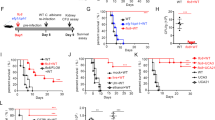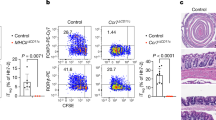Abstract
Despite the prevalence of γδ T cells in mucosae that are typically colonized by Candida albicans, little is known of the possible role of these cells in resistance to candidiasis. A sharp increase in the number of γδ T cells and macrophages following intraperitoneal inoculation of mice with C. albicans led us to examine the role of these cells in the immune response to C. albicans. We show that the γδT cells enhance macrophage nitric oxide (NO) production and anti-candida activity, in vitro. We also propose that the γδ T cells regulate macrophage function during candidiasis in vivo as well, because depletion of these cells abrogated inducible NO synthase expression in mucosae and enhanced murine susceptibility to candidiasis.
This is a preview of subscription content, access via your institution
Access options
Subscribe to this journal
Receive 12 print issues and online access
$209.00 per year
only $17.42 per issue
Buy this article
- Purchase on Springer Link
- Instant access to full article PDF
Prices may be subject to local taxes which are calculated during checkout
Similar content being viewed by others
References
Sternberg, S. The emerging fungal threat. Science 266, 1632–1634 (1994).
Bodey, G.P., Bolivar, R. & Fainstein, V. Infectious complications in leukemic patients. Semin. Hematol. 19, 196–226 (1992).
Romani, L. et al. Neutralization of IL-10 up-regulates nitric oxide production and protects susceptible mice from challenge with C. albicam . J. Immun. 152, 3514–3521 (1994).
Cenci, E. et al. Interleukin-4 and interleukin-10 inhibit nitric oxide-dependent macrophage killing of Candida albicans . Eur. J. Immun. 23, 1034–1038 (1993).
Vazquez-Torres, A., Jones-Carson, J. & Balish, E. Candidacidal activity of macrophages from immunocompetent and congenitally immunodeficient mice. J. infect. Dis. 170, 180–188 (1994).
Tao, X. & Stout, R.D. T cell-mediated cognate signaling of nitric oxide production by macrophages. Requirements for macrophage activation by plasma membranes isolated from T. cells. Eur. J. Immun. 23, 2916–2921 (1993).
Maródi, L. et al. Enhancement of macrophage candidacidal activity by interferon-γ increased phagocytosis, killing, and calcium signal mediated by a decreased number of mannose receptors. J. clin. Invest. 91, 2596–2601 (1993).
Yamamoto, S., Russ, F., Teixeira, H.C., Conradt, P. & Kaufmann, S.H.E. Listeria monocytogenes-induced gamma interferon secretion by intestinal intraepithelial γδ T lymphocytes. Infect. Immun. 61, 2154–2161 (1993).
Chan, J., Xing, Y., Magliozzo, R.S. & Bloom, B.R. Killing of virulent Mycobac-terium tuberculosis by reactive nitrogen intermediates produced by activated murine macrophages. J. exp. Med. 175, 1111–1122 (1992).
Cantorna, M. & Balish, E. Role of CD4+ lymphocytes in resistance to mucosal candidiasis. Infect. Immun. 59, 2447–2455 (1991).
Bistoni, F. et al. Mucosal and systemic T helper cell function after intragastric colonization of adult mice with Candida albicans . J. infect. Dis. 168, 1449–57 (1993).
Cole, G.T. et al. Retrovirus-induced immunodeficiency in mice exacerbates gastrointestinal candidiasis. Infect. Immun. 60, 4168–4178 (1992).
Balish, E., Filutowicz, H. & Oberley, T.D. Correlates of cell-mediated immunity in Candida albicans-colonized gnotobiotic mice. Infect. Immun. 58, 107–113 (1990).
Jensen, J., Vazquez-Torres, A. & Balish, E. Poly (IC)-induced interferons enhance susceptibility of SCID mice to systemic candidiasis. Infect. Immun. 60, 4549–4557 (1992).
Cutler, J.E. Acute systemic candidiasis in normal and congenitally thymic-deficient (nude) mice. J. Reticuloendothel. Soc. 19, 121–124 (1976).
Narayanan, R., Joyce, W.A. & Greenfield, R.A. Gastrointestinal candidiasis in a murine model of severe combined immunodeficiency syndrome. Infect. Immun. 59, 2116–2119 (1991).
Beckerman, K.P. et al. Release of nitric oxide during the T cell-independent pathway of macrophage activation. J. Immun. 150, 888–895 (1993).
Romani, L. et al. Natural killer cells do not play a dominant role in CD4+ subset differentiation in Candida albicans-infected mice. Infect. Immun. 61, 3769–3774 (1993).
Greenfield, R.A., Abrams, V.L., Crawford, D.L. & Kuhls, T.L. Effect of abrogation of natural killer cell activity on the course of candidiasis induced by intraperitoneal administration and gastrointestinal candidiasis in mice with severe combined immunodeficiency. Infect. Immun. 61, 2520–2525 (1993).
Skeen, M.J. & Ziegler, H.K. Intercellular interactions and cytokine responsiveness of peritoneal α/β and γ/δ T cells from Listeria-infected mice: Synergistic effects of interleukin 1 and 7 on γ/δ T cells. J. exp. Med. 178, 985–996 (1993).
Chen, J. et al. Immunoglobulin gene rearrangement in B cell deficient mice generated by targeted deletion of the JH locus. Int. Immun. 5, 647–656 (1993).
Koller, B.H., Marrack, P., Kappler, J.W. & Smithies, O. Normal development of mice deficient in β2M, MHC class I proteins, and CD8+ T cells. Science 248, 1227–1230 (1990).
Lundqvist, C., Baranov, V., Teglund, S., Hammarström, S. & Hammarström, M.L. Cytokine profile and ultrastrucrure of intraepithelial γδ T cells in chronically inflamed human gingiva suggest a cytotoxic effector function. J. Immun. 153, 2302–2312 (1994).
Follows, G.A., Munk, M.E., Gatrill, A.J., Convadt, P. & Kaufmann, S.H. Gamma interferon and interleukin 2, but not interleukin 4, are detectable in gamma-delta T cell cultures after activation with bacteria. Infect. Immun. 60, 1229–1231 (1992).
van der Heyde, H.C., Elloso, M.M., Roopenian, D.C., Manning, D.D. & Wiedanz, W.P. Expansion of the CD4−, CD8−. gamma delta T cell subset in the spleens of mice during non-lethal blood-stage malaria. Eur. J. Immun. 23, 1846–1850 (1993).
Lorsbach, R.B. & Russell, S.W. A specific sequence of stimulation is required to induce synthesis of the antimicrobial molecule nitric oxide by mouse macrophages. Infect. Immun. 60, 2133–2135 (1992).
LeFrancois, L. & Goodman, T. In vivo modulation of cytolytic activity and Thy-1 expression of TCR-γδ+ intraepithelial lymphocytes. Science 243, 1716–1718 (1989).
Mixter, P.F., Camerini, V., Stone, B.J., Miller, V.L. & Kronenberg, M. Mouse T lymphocytes that express a gamma delta T-cell antigen receptor contribute to resistance to Salmonella infection in vivo. Infect. Immun. 62, 4618–4621 (1994).
Chakir, J., Côté, L., Coulombe, L. & Deslauriers, N. Differential pattern of infection and immune response during experimental oral candidiasis in BALB/c and DBA/2 (H-2d) mice. Oral Micmbiol. Immun. 9, 88–94 (1994).
Tanowitz, H.B., Simon, D. & Wittner, M. Medical management of AIDS patients. Gastrointestinal manifestations. Med. Clin. N. Am. 76, 45–62 (1992).
Hiromatsu, K. et al. A protective role of γ/δ T cells in primary infection with Listeria monocytogenes in mice. J. exp. Med. 175, 49–56 (1992).
Stenger, S., Thüring, H., Röllinghoff, M. & Bogdan, C. Tissue expression of in-ducible nitric oxide synthase is closely associated with resistance to Leishmania major . J. exp. Med. 180, 783–793 (1994).
Boockvar, K.S. et al. Nitric oxide produced during murine listeriosis is protective. Infect. Immun. 62, 1089–1100 (1994).
Rosat, J.P., MacDonald, H.R. & Louis, J.A. A role for γδ+ T cells during experimental infection of mice with Leishmania major . J. Immun. 150, 550–555 (1993).
Mombaerts, P., Arnoldi, J., Russ, F., Tonegawa, S. & Kaufmann, S.H.E. Different roles of αβ and γδ T cells in immunity against an intracellular bacterial pathogen. Nature 365, 53–56 (1993).
Fu, Y.X. et al. Immune protection and control of inflammatory tissue necrosis by γδ T cells. J. Immun. 153, 3101–3115 (1994).
Vasquez-Torres, A., Jones-Carson, J., Warner, T. & Balish, E. Nitric oxide enhances resistance of SCID mice to mucosal candidiasis. J. infect. Dis. (in the press).
Di Rosa, R. et al. Changes in various immunological parameters in patients with recurrent vaginal candidiasis. Boll. dell. 1st. Sieroterapico Milanese 70, 499–504 (1991–2).
Cantorna, M., Mook, D. & Balish, E. Resistance to congenitally immunodeficient gnotobiotic mice to vaginal candidiasis. Infect. Immun. 58, 3813–3815 (1990).
Fidel, P.L. Jr., Lynch, M.E. & Sobel, J. Effects of preinduced Candida-specific systemic cell-mediated immunity on experimental vaginal candidiasis. Infect. Immun. 62, 1032–1038 (1994).
Haas, W., Pereira, P. & Tonegawa, S. Gamma/delta cells. Annu. Rev. Immun. 11, 637–685 (1993).
McMenamin, C., Pimm, C., Mckersey, M. & Holt, P.G. Regulation of IgE responses to inhaled antigen in mice by antigen-specific γδ T cells. Science 265, 1869–1871 (1994.
D.A., Ferrick, M.D., Schrenzel, Mulvania, T., Haiech, B., Ferlin, W.G. & Lepper, H. Differential Production of Interferon-γ and Interleukin-4 in response to Thl and Th2-stimulating pathogens by γδ cells in vivo Nature 373, 255–257 (1995).
Balish, E., Jensen, J., Warner, T., Brekke, J. & Leonard, B. Mucosal and disseminated candidiasis in gnotobiotic SCID mice. J. Med. Vet. Mycol. 31, 143–154 (1993).
Van der Heyde, H.C., Manning, D.D. & Weidanz, W.P. Role of CD4+ T cells in the expansion of the CD4−, CD8− γδ T cell subset in the spleens of mice during blood-stage malaria. J. Immun. 151, 6311–6317 (1993).
Green, L.C. et al. Analysis of nitrate, nitrite, and (15N) nitrate in biological fluids. Anal. Biochem. 126, 131–138 (1982).
Author information
Authors and Affiliations
Additional information
Department of Surgical Pathology, University of Wisconsin Medical School, Madison, Wisconsin, 53706-1532, USA
Rights and permissions
About this article
Cite this article
Jones-Carson, J., Vazquez-Torres, A., van der Heyde, H. et al. γδ T cell-induced nitric oxide production enhances resistance to mucosal candidiasis. Nat Med 1, 552–557 (1995). https://doi.org/10.1038/nm0695-552
Received:
Accepted:
Published:
Issue Date:
DOI: https://doi.org/10.1038/nm0695-552
This article is cited by
-
Functional properties of beetroot (Beta vulgaris) in management of cardio-metabolic diseases
Nutrition & Metabolism (2020)
-
Utility of Ruxolitinib in a Child with Chronic Mucocutaneous Candidiasis Caused by a Novel STAT1 Gain-of-Function Mutation
Journal of Clinical Immunology (2018)
-
Respective IL-17A production by γδ T and Th17 cells and its implication in host defense against chlamydial lung infection
Cellular & Molecular Immunology (2017)
-
Selective, efficient modulation of activated CD4+ αβT cells by the novel humanized antibody GZ-αβTCR targeting human αβTCR
Bone Marrow Transplantation (2015)
-
T-cell Subsets and Antifungal Host Defenses
Current Fungal Infection Reports (2010)



